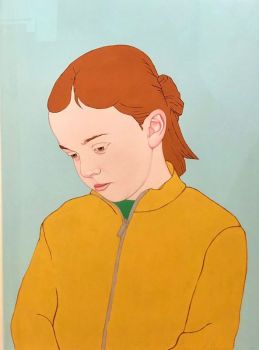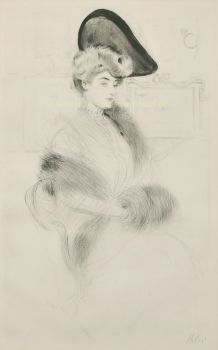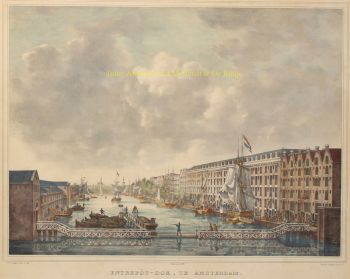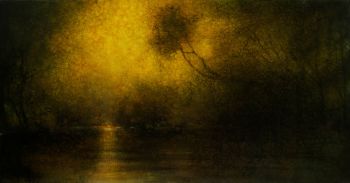Landscape 6 2024 - 2025
Othilia Verdurmen
60 ⨯ 120 cm
Prezzo su richiesta
Othilia Verdurmen
- A proposito di opere d'arteThe artist created a landscape that is printed on opera velvet and combined it with brass wire and beads and so created a play of light and shadow on the design. It is a unique piece.
- A proposito di opere artista
Othilia was born in Groningen, the Netherlands, in 1962. She grew up as the second daughter in a family with four children. Othilia was introduced to textiles early on, as there were plenty of them lying around the house due to her father's profession. Even as a young girl, she developed a strong affinity for the material, believing that anything made of textiles couldn’t be broken, and she wanted nothing more than to express her imagination through various fabrics. Her mother had a chest filled with cloths made from all sorts of fibers. Even her wedding dress was stored in this chest, though it once fell victim to a snipping session for a theatre play.
Sometimes Othilia’s father would come home with a suitcase from which small wonders would emerge. The floor would suddenly be scattered with samples, colors, and patterns, and the stories would begin. Distant journeys, other cultures, exotic foods. In this way, a piece of cloth became the fabric of a story. Filled with excitement and expectation, Othilia would touch it, as if she were transported to that other world. Occasionally, she would find small imperfections in the fabric—an error in the embroidery or a slight color deviation in the pattern. It was a reminder that human hands had made it, and that fired her imagination.
Othilia attended grammar school, where she first encountered mythology, which remained a fertile ground for her work, always connected to stories. She discovered the true meanings behind batik patterns, wajang, African masks, and art—Paul Klee, the Bauhaus, and other movements.
A path began to unfold before her. During this time, Othilia saw the Triangel Figurentheater for the first time, a surreal puppet theatre presented by Henk Boerwinkel, renowned worldwide. It left a lasting impression. After all, could textiles truly come to life like that? This performance stayed with her, but it took some time before she found her own way. In 1981, Othilia went to the Academie voor Expressie en Communicatie (AVEC) in Leeuwarden, wanting to work with people. At the Academie, she experimented with costumes, puppets, Commedia dell’Arte, masks, movement, and theatre. One of her inspirations was Pina Bausch, whom she visited in Wuppertal to study the effects of theatre where personal motives are woven into the work.
After graduating, Othilia contacted the Pop en Spel Kollektief, a professional theatre company. Under the guidance of Yvon Hofer, she learned the practical aspects of puppet-making. She created costumes, sets, and play figures. Othilia soon discovered that it was the image that told her the story. She looked at a figure through the eyes of an artist, a perspective that shaped her understanding of the qualities a puppet or figure needed. In addition to her work for the Collective, she began making a series of large, mythological animal figures. In 1995, the Natuurmuseum Fryslân gave Othilia the opportunity to create a major exhibition titled Nachtwereld (Nightworld). Visitors entered a constellation of passageways, traveling from night to day, leaving the noise of the world behind. It was a hybrid of visual art and theatre, with the story guiding visitors past various objects. A soundscape accompanied the project, with dramatic lighting enhancing the experience.
Othilia’s love for textiles persisted, as they softened everything and made the world tangible. Sound was muffled, like being in the womb.
Over time, Othilia’s work became more abstract and dynamic. Structures grew together associatively, forming compositions. The compositions were completed by soundscapes and changing light, creating a cinematic experience of the objects.
In 2006, Othilia began the Phoenix project. After a fire in 2009 destroyed her studio and the nearly completed work it contained, she decided to rebuild the Phoenix installation. Her work underwent a radical transformation. Through her structures, Othilia sought to capture the dynamics of emotion. The Phoenix project, with its extraordinary history, now holds a central place in her body of work.
Sei interessato ad acquistare questa opera d'arte?
Artwork details
Related artworks
- 1 - 4 / 12
- 1 - 4 / 24
Corstiaan Hendrikus de Swart
Mountain landscape with Lake1838 - 1900
Prezzo su richiestaKunsthandel Pygmalion
Jean-François Rauzier
Singapore by Night - Limited edition of 8 2017
Prezzo su richiestaVilla del Arte Galleries
Jean-François Rauzier
Balade d'Amsterdam 4 - Limited edition of 22015 - 2024
Prezzo su richiestaVilla del Arte Galleries
H.J. van der Weele
Horse and carriage in landscape1850 - 1900
Prezzo su richiestaKunsthandel Pygmalion
Jean-François Rauzier
Balade D'Amsterdam 2 - Limited edition of 2 2015
Prezzo su richiestaVilla del Arte Galleries
1 - 4 / 24- 1 - 4 / 12






























































